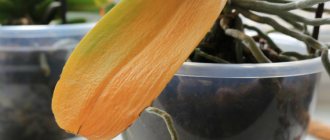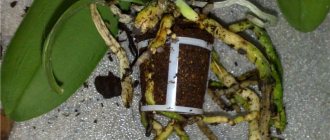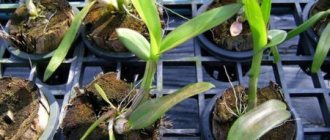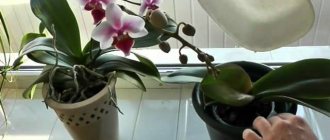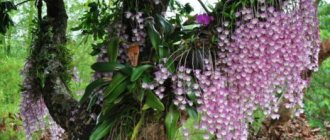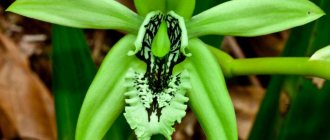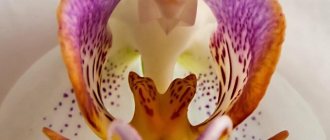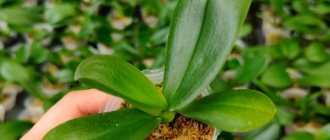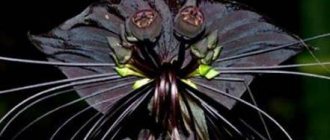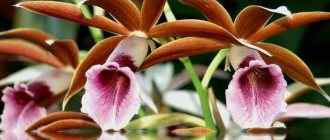Orchids are perhaps the most attractive plants in the world and are popular among flower lovers in every country. There is nothing surprising about this - the petals are of unusual shape, size and the fact that they grow quite quickly - help them stand out from many other indoor flowers. However, the most original orchid is, of course, the blue phalaenopsis.
Description and characteristics of blue phalaenopsis
Phalaenopsis orchid is a plant that grows on tree branches and feeds by means of aerial roots. The leaves have a pronounced green color, have an elongated shape and a shiny surface, and are arranged in the same way as in many other types of orchids - in two rows. The stems of the plants are short, and the peduncle is long, sometimes reaching 1-1.5 meters.
There is no specific schedule according to which phalaenopsis blooms, since it grows in tropical forests. In most cases, flowering occurs in late spring because there is more natural light at this time.
Phalaenopsis propagation occurs by vegetative method. To do this, cut off the side shoots extending from the peduncle or rosette of leaves. After the first roots form on the shoot, you can plant it in your own pot.
Types of orchids, their names and photos
In this section you will learn what types of indoor flowers there are, their descriptions, pictures of plants of the orchid family.
With bulbs
The bulb, or more precisely the pseudobulb (tuber, tuberidium) is a storage of nutrients. The thickening at the bottom of the stem, the “outer bulb.”
Plants with pseudobulbs belong to the sympodial type of development.
What types of orchids with pseudobulbs are there:
- lelia;
- oncidium;
- miltonia;
- odontoglossum;
- Cattleya;
- dendrobium;
- carrot orchid.
You can read more about the Lelia orchid here.
Unpretentious
Indoor phalaenopsis hybrids grow and bloom well in living rooms and are well suited for beginning gardeners. Most other species and varieties require a more individual approach.
Dendrobium, Cattleya, oncidium, Vanda are also quite easy to grow, observing the conditions: during the day it is 7 degrees warmer than at night, do not overwater in winter.
Cattleya (photo of flowers in pots).
Sympodial
Sympodial species grow in bushes, with several shoots from one rhizome:
- Cattleya;
- Cambria;
- oncidium;
- Cymbidium.
The main root is located horizontally inside the soil; new shoots with pseudobulbs easily grow from it.
Orchids are divided into monopodial and sympodial types.
Smelling
The aroma of orchids varies from completely absent to a strong, pleasant fragrance. Vanilla type flower is also used in the food industry.
The most odorous types:
- vanilla;
- lelia;
- miltonia;
- celogina;
- Cattleya;
- dendrobiums;
- phalaenopsis (many varieties);
- cymbidiums;
- Cambria;
- zygopetalum;
- miltoniopsis;
- oncidium.
Rare
The orchid family is so vast and unusual; there is a considerable list of rare species. Here are the most beautiful and rarest of them:
Royal blue phalaenopsis. Botanists from the Japanese university Chiba University created the Royal Blue variety based on the phalaenopsis Aphrodite, placing the blue gene in it. So far this miracle is not available to ordinary amateur flower growers. The basis of the unique new species is also rare - the phalaenopsis Aphrodite orchid is very difficult to propagate by seeds, so it is not grown on an industrial scale;
Royal blue phalaenopsis.
- white heron orchid, habenaria or leopard radiata;
- Flying Duck Orchid (Caleana Major);
- Odontoglossum.
Indoor
Varieties of indoor orchids include many varieties, since with skillful care even the most exotic plant will feel good, but with an inexperienced and inattentive gardener, even a stable hybrid phalaenopsis can quickly die.
Types of indoor orchids:
- phalaenopsis and its varieties;
- dendrobium;
- Wanda;
- brassia;
- miltonia;
- lelia;
- zygopetalum;
- celogina;
- cymbidium;
- oncidium;
- odontoglossum and many other species.
Find out more about what indoor orchids are and a description of these plants in our article below.
New
Based on natural species, every year new orchid hybrids are created for indoor cultivation with an extended flowering period and a reduced dormant period, of all kinds of shapes and colors.
New varieties are grouped according to the place of creation; for example, Taiwanese hybrids are distinguished.
By mixing the characteristics of different species, we obtained novelty phalaenopsis, on which new buds grow from the apical bud right during flowering. You can see a picture of the novelty variety below.
A variety of Phalaenopsis novelty flower.
Is phalaenopsis blue?
The answer to such a question will most likely disappoint lovers of exotic plants, since in nature there are no such shades of buds of this variety of flowers. This is due to the fact that phalaenopsis lacks the gene responsible for the blue color of the petals. If you see such a plant with blue flowers on the counter of a flower shop, you should know that they are colored.
An orchid with large white flowers and a yellow edging is used as the base. In most cases, in order to color it, injections are made with a dye directly into the peduncle or its base. Sometimes they begin to dye phalaenopsis by pouring tinted water over it, then not only the flowers, but also the leaves and the root system turn blue.
See what types of orchids there are.
History of selection
How did blue orchids appear? For example, the well-known Phalaenopsis Royal Blue has its own history. It is known that phalaenopsis of this color began to be created in 2 organizations:
- Florida's Silver Vase Farm debuted blue-colored orchids at its 2011 tropical plant exhibit.
- In the Dutch nursery Geest Orchideen . The breeders of this company even received an award for such an unusual plant. Since 2009, they have created several different varieties using the developed technology. They make up the Royal Family collection.
The secret of this technology is not disclosed. It is known that white phalaenopsis is installed in a special environment . To create it, natural ingredients are used and the process is not dangerous for flowers. But, the next time they bloom, they will be white or with a slight blue tint. This information must be indicated on plant labels.
Orchids come in a wide variety of colors. We have prepared articles about yellow and pink orchids on our portal.
Is there a blue phalaenopsis?
For many years, breeders conducted numerous experiments trying to develop orchids of unusual colors. Scientists from Japan managed to achieve blue color. They presented a phalaenopsis, which they named “Royal Blue”. The plant actually had a bright blue hue. To obtain this color, breeders introduced the gene of an orchid from Asia, Commelina, into the white flower of the Aphrodite species. The introduced gene was responsible for the blue color of the petals. Thus, the resulting hybrid began to bloom with buds of the required color.
This variety of orchids blooms profusely with small flowers, the size of which does not exceed 5 cm. Up to 30 buds can form on one stem.
This orchid is an exclusive flower; it is currently impossible to find it in stores.
How did the blue phalaenopsis orchid appear?
The world's first blue orchid was exhibited at an international exhibition in America. The flower aroused great interest among people, and just a few months after the event, Phalaenopsis blue (Royal) was presented at the Dutch flower competition.
It should be said that the manufacturers openly say that this shade is the result of coloring using a secret technology that has received a patent. Accordingly, in the future the orchid will bloom with white flowers.
Hybrid varieties
Phalaenopsis orchids with a blue tint of flowers still exist; there are stems with lilac-blue, pale blue, violet-blue flowers. The most famous varieties with blue color on the arrow are:
- Aphrodite blue became famous in 2013 after a group of Japanese breeders demonstrated their new transgenic trunk. It is based on the Aphrodite variety, to which the “blue” Commelina gene has been added;
The world's first blue phalaenopsis, Aphrodite blue, obtained through genetic engineering.
The following varieties are dyed blue:
- Royal blue phalaenopsis nothing more than an artificially colored standard. In subsequent blooms, its flowers will most likely be plain white or cream. It is usually dyed by injection;
Royal blue phalaenopsis (Phalaenopsis Royal Blue). - Calimero Royal Blue is a mini standard. Its color is also artificial and is easy to care for. It is enough to maintain normal air humidity, carry out timely watering and periodically spray the miniature orchid. Most likely, the next flowering will not please you with blue flowers. You can watch this variety in the video:
Interesting! Phalaenopsis Aphrodite blue is still almost not common among gardeners. Its cost is quite high and only a few can afford such luxury.
Besides these, there are many other varieties that undergo the dyeing process. But they look less impressive.
Rules for caring for blue phalaenopsis
Home care for blue orchids does not differ significantly from care for other types of this flower. The main condition for the successful growth of blue phalaenopsis is ensuring optimal humidity, heat and light.
The required level of humidity can be achieved by regularly spraying the flower with a spray bottle. It is necessary that the water is not too cold, the optimal temperature is 18-20°C.
In order for the phalaenopsis to have enough light, it should be placed on a window located in the south, southwest, southeast.
On sunny summer days, you need to provide the plant with shade, otherwise it may get burned. The temperature during the day should not exceed 20°C. At temperatures below 15°C and above 25°C, the orchid may become sick, growth will be slower, and other problems associated with flowering may arise.
Pests and diseases
Phalaenopsis loses its former appearance primarily due to improper care. For example, leaf wilting is often associated with a lack of moisture, and if the leaves rot and turn yellow, then watering should be reduced. In these cases, it is also recommended to check the root system for dry or rotten roots. If they exist, they are removed.- With too much light, the leaves look pale and faded, and dark spots appear on them. A decrease in leaf size, shine, or lack of flowers indicates excessive darkening.
- If a flower lacks nutrients, its leaves become dull, and when overfed with fertilizers, yellow chemical burns appear on them.
- When the conditions are met, and the plant withers, then the problem is a pest or disease.
- Thus, phalaenopsis is susceptible to attacks by aphids, scale insects, chickweeds, and thrips. To get rid of them, the plant is washed, and only after that they begin to treat it with pesticides.
- The flower is also vulnerable to brown leaf spot, rot, fungal and viral diseases. Treatment is carried out with special drugs according to the instructions.
Care after purchase
When a flower is brought to a new place, its buds may begin to fall off. In such a situation, it is necessary to assess the condition of the root system. If the paint was injected into the roots, then it will no longer be possible to help such a plant. In the case where the pigment is injected into the peduncle itself, the chances that the orchid will emerge will be higher.
Find out why orchid leaves crack in half.
To resuscitate a painted phalaenopsis, you need to cut off the stem filled with a dye. Then carry out the following manipulations:
- Remove the plant from the pot. This must be done carefully so as not to injure the roots.
- Rinse the root system thoroughly using warm water. In this case, all roots should be checked for the presence of injection marks. If the paint was introduced through the roots, then rotting will be observed in the area where it was injected.
- All affected areas must be cut off.
- Then the cut areas need to be treated with ash. They need to dry well.
Next, the flower can be planted in a pot, into which fresh substrate should be poured.
The substrate in which the plant was previously must be thrown away. It cannot be used again, since it contains many chemicals and other harmful substances that were used to paint the phalaenopsis.
